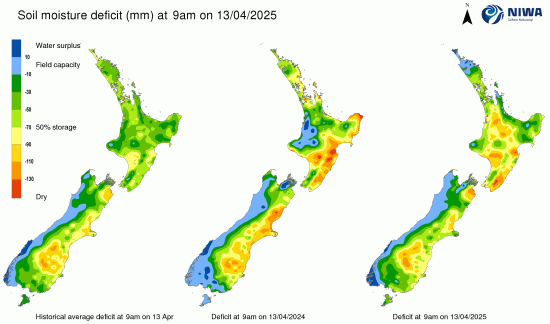
Here are the key things you need to know before you leave work today (or if you work from home, before you shutdown your laptop).
MORTGAGE RATE CHANGES
There are many floating rate changes today after the OCR cut. A comprehensive list is here. If there are fixed rate changes, those changed will be here. All rates are here.
TERM DEPOSIT/SAVINGS RATE CHANGES
For all the matching savings account changes today, see this. If there are also term deposit rate changes, they will be summarised here. In addition to those, Sharesies trimmed rates too. All updated term deposit rates less than 1 year are here, for 1-5 years, they are here.
OCR CUT
The RBNZ, newly led by Christian Hawkesby, cut the OCR today by -25 bps to 3.50% as expected. Details here.
NO MORE CONSTRUCTION INFLATION
Residential construction costs were up less than +1% in the year to February, after several years of high cost growth.
STILL WELL OVER-STOCKED
The stock of properties for sale continues growing on Trade Me Property, now at 49,155 residential listings. Autumn price signals are mixed.
FORMAL WARNING
The Commerce Commission has issued a warning and negotiated enforceable undertakings from South Canterbury-based Alpine Energy after an accounting error resulted in it overcharging customers by $16.9 mln.
NZX UPDATE
As at 3pm, the overall NZX50 index is down -0.5% and the weekly change is now -3.8%. Year-to-date it is down -9.3%, and the change from this time last year is now -0.5%. SkyCity, The Warehouse, EBOS, and Hallenstein are the biggest gainers today as Summerset, Vista Group, Gentrack, and Kiwi Property Group all lead the decliners. Market heavyweight F&P Healthcare is down -0.6% so far today.
LITTLE-CHANGE
Today's GDT Pulse milk powder action brought little change, and the changes there were, were less than expected.
BIGGER BUFFERS
The minimum stockholding obligation for diesel importers will increase from 21 to 28 days’ cover, bolstering New Zealand’s diesel reserves and resilience to supply disruptions, the government has announced. The industry isn't happy, claiming the costs will be passed on to consumers. (Sounds like the banks. Every industry hates holding "more capital" to protect from risks, and always claim "consumers will pay". But when the s-hits-the-f, they will expect the taxpayer to bail them out.)
A CHANGE IN THE WEATHER FORECAST
Metservice and NIWA are being merged. Technically, NIWA will acquire MetService. Both are Government owned. The government isn't keen on the benefits of competition, preferring a monopoly.
GLOBAL ECONOMIC QUAKE
In this update, we are not ignoring the biggest global story, the almost complete breakdown in the US-China relationship. It is an earthquake from which will be many aftershocks, many felt here. See our Breakfast Briefing for more details (or almost every other news service).
SWAP RATES HOLD
Wholesale swap rates are probably little-changed at the short end today and a little firmer over longer durations. Update: In a sharp end of session move, these rates fell rather sharply. Keep an eye on our chart below which will record the final positions closer to 5pm. The 90 day bank bill rate was up +2 bps at 3.49% on Tuesday. The Australian 10 year bond yield is up +13 bps at 4.39%. The China 10 year bond rate is down -1 bp at 1.65%. The NZ Government 10 year bond rate is up +21 bps at 4.80% from this time yesterday while today's RBNZ fix was at 4.62% and up +9 bps from Tuesday. The UST 10yr yield is now just on 4.37% and up +21 bps from this time yesterday. Their 2yr is up +1 bps at 3.73%, so that positive curve has now moved out to +64 bps, and its most suince mid 2022.
EQUITIES FALL HARD AGAIN
The NZX50 is down -0.3% in late Wednesday trade. The ASX200 is down -1.4% in afternoon trade. Tokyo has opened down -2.6% in early Wednesday trade. Hong Kong is down -1.3%, while Shanghai is down -0.3% at its open. Singapore has opened down another -1.4%. On Wall Street, the S&P500 was down -1.6% in Tuesday trade.
OIL DIVES
The oil price is -US$4 softer from this time yesterday and now just over US$57.50/bbl in the US, and just on US$61/bbl for the international Brent price.
CARBON PRICE LITTLE-CHANGED BUT SOFTER
The carbon price is only marginally lower again today and now at NZ$54.50/NZU. The next official carbon auction is on Wednesday, June 18, with a $68 floor price. See our new daily chart tracker of the NZU price for carbon, courtesy of emsTradepoint.
GOLD HOLDS
In early Asian trade, gold is down -US$1 from this time yesterday, now at US$3003/oz.
NZD FALLS
The Kiwi dollar is down -40 bps from this time yesterday at 55.4 USc. At one point today it hit its lowest level since March 2009, a 16 year low, under 55 USc but has since recovered. Against the Aussie we are down -10 bps from yesterday at 92.4 AUc. Against the euro we are down -50 bps at 50.3 euro cents. This all means the TWI-5 is down to 65.3.
BITCOIN FALLS
The bitcoin price is down -5.3% from this time yesterday, now at US$75,712. Volatility of the past 24 hours has been high at just on +/- 3.5%.
Daily exchange rates
Select chart tabs
Daily swap rates
Select chart tabs
This soil moisture chart is animated here.
Keep abreast of upcoming events by following our Economic Calendar here ».

17 Comments
US 10 Year keeps surging. Yield on the 10-year hit 4.5%, and the yield on the 30-year hit 5%. The Fed doing emergency rate cuts tomorrow morning and announcing massive QE program? Is a 1987-style crash on? Something's got to give.
And how this impact the Aussie banks' ability to pump out mortgages like no tomorrow as global wholesale funding rates go up?
Rumors circulating that a bank is blowing up and fire selling treasuries to raise liquidity quickly and withstand margin calls.
Was just looking at this also. RBNZ drops OCR and the NZ 10y spikes upwards not downwards.
Something isn’t right.
if you are considering potential forward earnings estimates as a point that markets could bounce.... ie is 15 or 13 reasonable
think again
As the US sharemarket teeters on the cusp of a bear market, analysts have barely started to adjust their earnings forecasts to reflect a severe economic shock that investment strategists fear could accelerate the meltdown on Wall Street.
Strategists believe those forecasts remain far too optimistic, given the growing risk of a global recession – Goldman Sachs is expecting earnings growth of just 3 per cent, while UBS said there was a risk that S&P 500 companies post zero growth.
The OCR has little correlation to the 10 yr, you have to understand the difference between long term and short term expectations.
Probably nothing..... probably the unwind of ‘the basis trade
Treasury yields rose as the selloff in U.S. government bonds continued Tuesday following a historically bad start to the week.
A bad auction was being blamed for investors ditching Treasuries Tuesday, but at least part of the reason for the drop could be the unwind of ‘the basis trade,’ a popular hedge fund strategy.
On Tuesday, the 10-year Treasury yield rose 0.096 percentage point to 4.259%, while the 30-year yield rose 0.123 point to 4.714%, sending the iShares 20+ Year Treasury Bond exchange-traded fund
In just the past two days now, the 30-year Treasury bond has marked its biggest gain in yields since the pandemic began. The 10 year’s gain has been more modest, but still not good. Higher yields mean bond prices are falling
These kinds of moves aren’t normal. On Monday, the 10-year yield dropped as much as 0.144 points but ended up 0.168 points from Friday’s close. This sort of gyration, where the 10-year yield fell at least 14 basis points and gained the same or more, has happened only one time since 2006—the day after Donald Trump was elected president in 2016.
The action has been captured by the MOVE Index, a measure of implied volatility for the Treasury market, which has surged to its highest level since Oct. 3, 2023.
It was “a ‘tell your grandchildren I was there’ day in the bond market,” wrote Jim Bianco, president of Bianco Research, on LinkedIn on Monday.
At first, the swings seem puzzling. There hasn’t been any big new economic data, and the tariff and recession headlines should push investors into buying Treasuries—not selling them.
Speculations that foreign investors have been selling bonds to get more U.S. dollars have made the rounds on social media site X and within Wall Street’s circles. It’s hard to quantify foreign selling. Much of it is rumor driven and the auction of three-year notes on Tuesday didn’t show any signs of central bankers backing away.
But the fact that the auction saw poor demand from domestic buyers, like pension funds and insurance companies, who took up just 6.2% of supply versus the more typical average of 19%, is a bad sign for the upcoming auctions and bonds overall. All important 10-year and 30-year bond auctions are scheduled for Wednesday and Thursday, respectively.
Others have also started talking about the unwind of ‘the basis trade,’ a trading strategy long been used by hedge funds.
Here’s how the trade works: Hedge funds are on the hunt for when the price of a government bond diverges from its future contract, an agreement to buy the bond at a later date for a specified price.
When a hedge fund spots a meaningful difference, it buys the cheaper bond and shorts the more expensive futures contract. In other words, the firm borrows the futures contract and quickly sells it, with the hope that the higher futures price will fall to the cheaper bond price—the way it should.
At the point that the prices align—the bond price increases and the futures price drops—the hedge fund exits the trade, making a profit.
But make no mistake, the basis trade is extremely risky because it’s so highly leveraged. The hedge fund ‘leverages’ the bet by borrowing money, sometimes 50-100 times.
This risk—along with less visibility on the trade—has been criticized by some market observers. Research shows this speculative trade contributed to Treasury market stress and volatility in March 2020.
Proponents, on the other hand, argue that the basis trade are an important source of liquidity and demand for Treasury securities.
The basis trade is big. Today, it’s about “$800 billion [and] will continue to expand as U.S. government debt levels continue to grow,” Torsten Sløk, Apollo Global’s chief economist wrote Tuesday, pointing out that an outside shock can lead to the hedge funds rapidly unwinding positions, leading to larger disruptions.
To be sure, when moves in the bond market are rapid and not easy to explain, the basis trade often gets called out. There could be simpler explanations for the ups and downs. Ian Lyngen, head of U.S. rates strategy at BMO Capital Markets, cites exceptionally high uncertainty combined with the assumption for higher inflation because of the Trump tariffs among other reasons. Higher inflation usually lead investors to demand more returns. The fiscal deficit situation is also getting cited.
Still, those worries have been talked about a lot and don’t explain—convincingly—the large dumping of bonds.
Basis trade is a real concern: Hang on for the ride.
For another source of info I'm copy/pasting part of a ZH article available to subs, however they come to a similar conclusion. ZH thinks the Fed will have to step in and do QE etc- not that Powell will be wanting to bail-out Trump's trade war.
What's going on here? Well, the simple explanation is that the most popular trade among the hedge fund community, the abovementioned basis pair trade of long Treasuries, short swaps is in the process of terminal, catastrophic unwind (here some blame Trump for unleashing the stagflation genie with his trade war, others accuse China of dumping Treasuries in response, yet others say it's just long overdue that the basis trade finally blew up), and as a result of the panicked scramble to unwind, swaps are now massively outperforming Treasuries, which are getting dumped, and pushing swap rates far below Treasury yields, resulting in record negative swap spread rates!
The bottom line is that funds and banks are panic selling Treasuries to raise cash, while adding swaps to maintain exposure to interest rates, leading to the record low spread between swap rates and Treasury yields across the curve: yes, we have shown the 3Y SOFR swap spread chart above, but one can look at every tenor across the curve and get the same message.
Translation: basis trade implosion translating in swap spread stop-out devastation!
The Financial Times, which picked up on the topic of the collapsing basis trade topic about 10 days after us, quoted a hedge fund manager who said that "hedge funds have been liquidating US Treasury basis trades furiously."
The "furious" panic to unwind the basis trade means the "paper" leg of the trade has pushed yields soaring, something which can be seen by observing the unprecedented 50bps move higher in the 10Y yields in just the past 2 days (a move which may easily have gotten some additional kick from Chinese selling of US paper too)!
Every industry hates holding "more capital" to protect from risks, and always claim "consumers will pay". But when the s-hits-the-f, they will expect the taxpayer to bail them out.)
So the consumer pays either way, either proactively, or retrospectively.
Japan's MOF, FSA, and BOJ to hold meeting on markets at 0700 GMT
This usually happens when there are extraordinary events in markets and today definitely fits that bill.
No doubt this will be about providing liquidity. Someone got blown out.
https://www.forexlive.com/news/japans-mof-fsa-and-boj-to-hold-meeting-o…
https://www.afr.com/policy/economy/why-we-shouldn-t-rule-out-an-economi…
imagine the FED pulling FX Swap lines.....
and AEP no one can cover a meltdown like AEP
https://www.afr.com/world/north-america/if-it-looks-alarming-now-wait-f…
Some may groan, but this was all predictable and predicted. Indeed, inevitable.
Gwynne Dyer had a reasonable piece in the ODT today - he's a techno-optimist but a CC understander, a common-enough combo. Good on history and geopolitics.
Thinks Israel and the US will hit Iran within months. Thinks the US will only have Russia as an ally. Maybe. Thinks Europe and China and the rest of us, might likely form a bloc, not as tight as the past one.
He doesn't get energy, though, nor Limits. So factoring-in a fight-to-the-dearth is not on his horizon.
He doesn't get energy, though, nor Limits. So factoring-in a fight-to-the-dearth is not on his horizon.
This is starting to sound silly.
Humans have behaved like this, forever.
Most people acknowledge the world has finite resources.
How could you distinguish typical human behaviour from the "the world's gotta end by 2050" story?
Russia is not now what Russia once was. Reagan and Thatcher and Co put paid to that and China furnished the requisite fulcrum. Russia’s major threat to its own security, is to the east. President Xi in quietly abetting Putin’s adventure in Ukraine has witnessed Russia resultantly, steadily reduce itself, militarily, economically and socially while simultaneously, increasing its dependence on China five fold. 1.4 billion people versus 340 million, as neighbours, are at odds of extremely different lengths. China, the Yuan Dynasty, has been all over there before. Read your history and you will find no evidence of any two dictators ever enduring long in either co-operation or mutual satisfaction. Watch that space.
This is also a distinct possibility.
China needs fuel
America's going to make it harder to source from the ME.
50-Day 5,802.74
200-Day 5,757.99
Death cross about to happen ?
good buying coming up https://www.zerohedge.com/the-market-ear/death-cross-countdown-no-real-…
GLOBAL ECONOMIC QUAKE
Worthwhile insights from Canadian PM (first few minutes of the clip);
https://www.youtube.com/watch?v=E4FVdItR_LE
The kind of leader, with the necessary knowledge and experience, that is needed in this type of crisis.
There was an announcement a couple of days back from the Singaporean PM also. Anything and everything to steady confidence in the markets and best prevent joe public getting spooked and pulling their investments. Even this morning on the radio with guest speakers advising not to panic and go making rash decisions with kiwisaver funds, same thing.
Ah yes erstwhile Governor of the BOE. A climate alarmist. Must have changed his spots now that he is PM of Canada and Canada is a big exporter of fossil fuels. Don't know how much Canada uses internally. So its OK to export fossil fuels but not OK to use them in Canada.
At least he has a financial background so hopefully his climate alarmism is drastically tempered for Canada's sake.
Went a bit further into the clip and didn't know that Canada itself has interstate trade barriers. Also see a another Canadian politician who is a Khalistani sympathiser, if not supporter, in the video. Seems M Carney needs his support as did Trudeau.
Maybe we can import Canadian lumber to keep our lumber industry honest?


We welcome your comments below. If you are not already registered, please register to comment.
Remember we welcome robust, respectful and insightful debate. We don't welcome abusive or defamatory comments and will de-register those repeatedly making such comments. Our current comment policy is here.